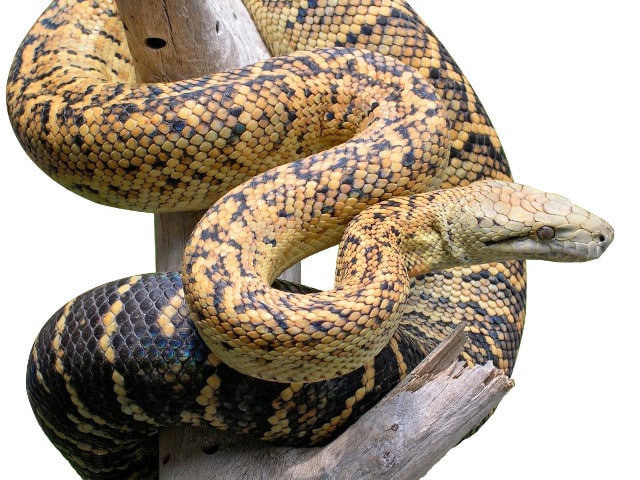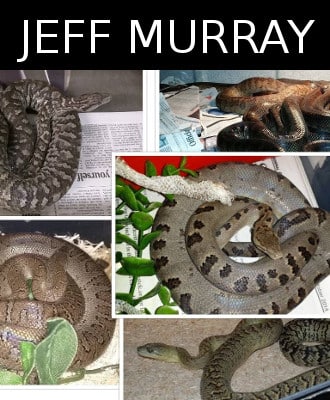Image Credit : Jeffrey Lemm
The Jamaican boa is a medium sized boa species. Chilabothrus subflavus have golden green around the head and along the anterior section of the body, with black zigzag crossbars, becoming black toward the posterior end of their body.
The Jamaican Boa is listed as CITES I/App I. It was placed on the Protected List by the Jamaican Gov’t in 1945 and the USFWS in 1970. It is threatened in Jamaica by habitat destruction, introduced predators and unwarranted killing by local residents.
- Scientific name : Chilabothrus subflavus
- Distribution : Jamaica
- Average Size : 1.8 m (6 ft)
- Life Span : 20 years or more
- Difficulty : Intermediate
Housing
Chilabothrus subflavus can get quite large, especially females, reaching lengths of 7+ feet as adults. A full frown Jamaican boa will require a spacious enclosure in the realm of 1.8 x 0.6 x 0.45 meters (LxWxH) (6 x 2 x 2 feet). A hide box at both the cool and warm ends is recommended as the boas will thermoregulate between the two. A water bowl that cannot be tipped over is recommended. The water should be replaced every other day, at a minimum, and immediately if soiled. Climbing material will be utilized if provided, though not a necessity.
Newborn and up to 18 month old youngsters can be housed in a rack system with tubs that measure 0.3 x 0.2 x 0.1 meters (LxWxH) (1 x 0.6 x 0.3 feet). A hide box, small water bowl, some artificial greenery for shedding and a substrate such as shredded aspen will fill the requirements for adequately housing them.
Hide box
A hide box is required for the boas to feel secure and thrive. Sterilite containers such as the 18 Qt or 12 Qt. can be used if a hole is cut in the short side. The hides can be easily removed, cleaned or replaced as often as needed.
Substrate
Substrate for newborns and youngsters should be something they can burrow in such as shredded aspen, etc. As they get larger, the substrate can be switched to paper or something similar. Anything that can be replaced quickly, whether entirely or with spot cleaning.
Lighting – Heating
Lighting is accomplished using an LED or bulb set on a timer that mimics actual day and night cycles. It is important to take into consideration whatever is used, it does not add any significant increase to the ambient temperature which should be around 24-27 °C (75-80 °F). The ambient temperature is lowered to 23-24 °C (73-75 °F) during night time.
Heat can be provided by several means; heat tape, radiant heat panels, heat lamps, etc. Regardless of material used to provide heat, a controller must be used to accurately control and monitor proper temperatures. A hot spot in the range of 30-31 °C (86-88 °F) is encouraged, especially after feeding and while a female is gravid. The hot spot should not be provided 24 hours a days, but rather like a normal photoperiod in the wild. A backup thermometer is also recommended to prevent any mishaps should a thermostat fail or malfunction. Standard boa temperatures will suffice for keeping Chilabothrus subflavus healthy and feeding.
Water
One of the most important things you can do for your boa is ensure it has access to clean/fresh water daily. Bowls should be regularly cleaned with a water/vinegar/bleach solution. This same solution can be used to clean the enclosure with a spray bottle.
Humidity
Ambient humidity (40-60 %) is often enough for Chilabothrus subflavus. However, winter climates can be especially dry and adding a little water to the substrate if a rough shed occurs will often solve that problem. Humidity and air circulation go hand-in-hand and it is important that the boa not be maintained in stagnant air. Using a fan in the room where the boas are maintained will alleviate this problem.
Feeding
Newborn Chilabothrus subflavus require ectothermic prey such as appropriately sized anoles or mourning geckos. They can be switched over to pink mice after several months using the old “scenting technique” of rubbing anoles on the PM or covering the PM with chick down. Either technique works with some babies preferring one over the other. Once switched over to rodents the youngsters grow quickly. Adults will take large rats and fowl with zest. If fed an usually large prey item, the babies may soak in their water bowl for a day or two to offset the weight of the prey item.
Handling
If one wants to be able to handle the adults then handling should take place at an early age. Chilabothrus subflavus can be very mean as adults if not handled with some regularity. Musking and biting are normal responses to handling but slowly fade with regular contact. They can be enclosure defensive so using a hook to gently remove them from the safety of their home may be required and is recommended.
Cleaning
As with any collection, cleanliness goes a long way toward a healthy boa. Spot cleaning, even daily, is a necessity if you want to have a long-lived Chilabothrus subflavus. Cleaning of the entire enclosure should be done quarterly to ensure an adequately sterile environment. Furnishings should be cleaned and sterilized as well. Water bowls should be cleaned, not rinsed, every couple of days or when soiled. Anything too soiled should be discarded and replaced immediately.
Shedding
Shedding is a consequence of growth and proper diet. If a rough shed occurs, humidity should be increased during the boa’s shed cycle to prevent retained eye caps or skin. A boa can be soaked in a tub to loosen any retained skin and then hand shed to remove any retained skin.
Potential Health Problems
As with any collection, cleanliness of the enclosure, tools, surrounding area is an important part of keeping your boas healthy and problem free. Stool samples should be periodically examined by a veterinarian to ensure nothing sinister is taking place in your collection. The larger a collection, the greater the chance of illness or disease-cleanliness is your first step in preventing either of these.
Source
The information contained in this care sheet reflect the opinions and methods of the mentioned breeder, based on their expertise and long-established experience.

